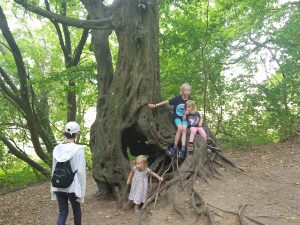Got Elves?
Readers, please enjoy this guest blog post by Linda Raedisch, author of Night of the Witches, Old Magic of Christmas, and the new Lore of Old Elfland.

The Rumpelwichtelbaum at the Viking Museum in Haithabu, Germany.
When my editor asked me if I had any special wishes for the cover of Lore of Old Elfland, I told her what I didn’t want: elves. If there absolutely had to be elves on the cover, I said, they should be well camouflaged, covered in lichen, tucked away among the roots of trees. Then I thought of what I did want: a tree, and not just any tree, but one particular European beech now known in our family lingo as the Rumpelwichtelbaum. The Rumpelwichteln are the peevish subterranean wights in the German translation of Astrid Lindgren’s Ronja, the Robber’s Daughter. In English, they’re “rumphobs.” You could call them elves. Because we all love this story, it’s become our tradition to photograph the youngest children of our extended family hiding among the roots of this tree.
In my book, I talk about my family’s long-standing relationship with The Hobbit (published, coincidentally, the year my mother was born), but our dealings with the elves extend beyond that. I’ve given away most of the books I owned as a child, but I’ve held on to all the ones with elves in them. As a child, I couldn’t read Die Heinzelmännchen von Köln, but I loved the pictures of the industrious little Heinzelmännchen doing all the housework while the people of Cologne slept. Even closer to my heart were the Mainzelmännchen, cartoon dwarves who preceded the commercials on the Mainz television station, ZDF. Every time we went to stay with my grandmother in Germany, my sister and I got to pick out one new rubber Mainzelmännchen doll each. (The resulting tribe of eight now resides with me.) Each time my slightly younger native cousins came to visit our grandmother, they made a beeline for her bottom kitchen cupboard where the Mainzelmännchen hid treats for them. At six, I didn’t believe the Mainzelmännchen were real, but I was still miffed that they never left any treats for me.
When I insisted that any elves on my book cover had to be camouflaged, I was picturing the ones in my falling-apart, 1967 edition of Little Red Riding Hood, illustrated by Jean Winslow. I don’t know if my sister and I ever actually read the story; we just pored over the pictures, hunting for the sometimes cute but more often sinister faces of the elves peeking out from behind the tree trunks and rocks. I got my wish: there aren’t any elves on the cover of The Lore of Old Elfland, at least not that I’ve been able to spot, and the tree framing the title looks very much like the one in the photo I sent my editor of that European beech surrounded by my own and my cousin’s children. I don’t know what elves their children’s children will revere—or fear—but I hope they’ll still assemble at the sacred Rumpelwichtelbaum.
Our thanks to Linda for her guest post! For more from Linda Raedisch, read her article “A Culture of One: Creating Your Own Elfland.”









